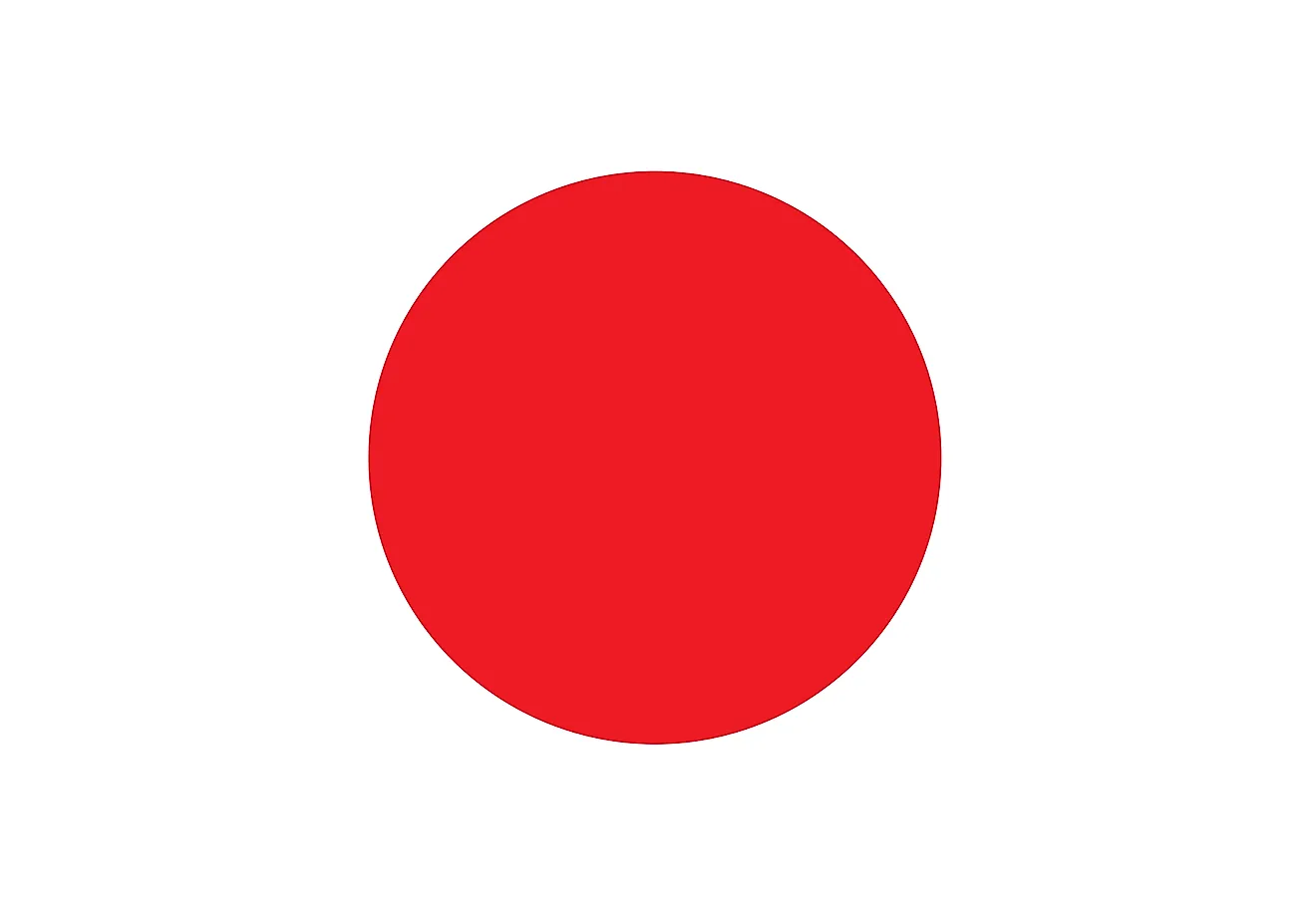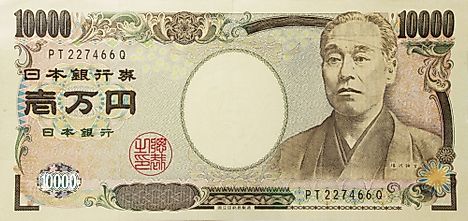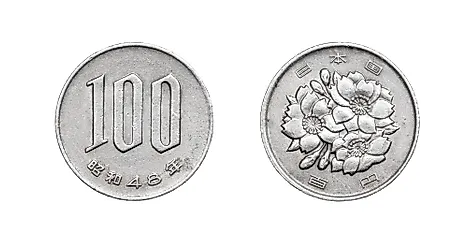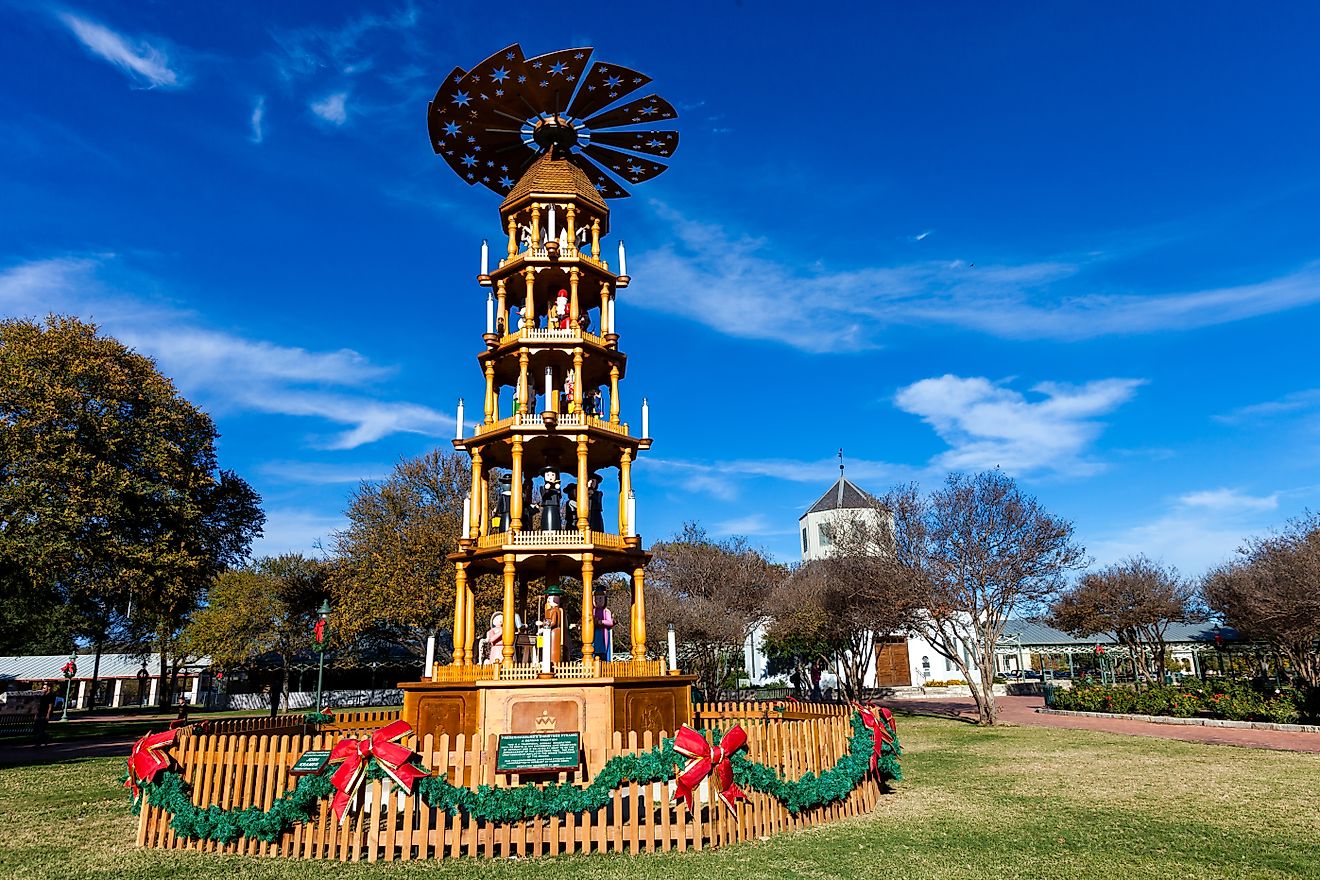Flags, Symbols, & Currencies of Japan

The national flag of Japan was adopted on January 26, 1870, and officially recognized on August 13, 1999, following the passage of the Act of National Flag and Anthem. The flag is officially named the Nisshoki, which means the sun-mark flag. This name refers to its appearance, which is a crimson circle set on a white background. A proper Japanese flag must have a height to length ratio of 2 to 3. Additionally, the circle must be placed precisely in the center of the white field and measure three-fifths of the length of the flag. The largest Japanese flag on record is located in the Shimane Prefecture, where it flies outside of the Izumo Shrine. Its measurements are 44.6 feet by 29.5 feet and is hung at an elevation of 154 feet.
Symbolism
The Japanese flag represents the sun, which has important religious and mythological significance in the country. Local beliefs suggest that Amaterasu, the sun goddess, is a direct ancestor of the Emperors of Japan. This relation between the sun goddess and the Emperor give legitimacy to those in power. In fact, the Emperor is often referred to as the Son of the Sun, and the country is often referred to as the Land of the Rising Sun. According to historical accounts, the first sun-themed flag was used in 701 AD, during the reign of Emperor Monmu. The use of this sun symbolism has continued throughout the history of Japan. Emperor Go-Reizei is said to have given the Unpo-ji Temple a sun flag during the 1000s, and during the 1800s the Japanese Empire began utilizing this sun-motif on its naval and merchant ships.
The centered sun symbol (called Hinomaru) has been an important part of Japan's flag for thousands of years and is said to represent a prosperous future for Japan. The white background color symbolizes the purity, honesty, and integrity of the people of Japan.
Use of the National Flag of Japan
Previously, the citizens of Japan were required to display the national flag during holidays and other special celebrations. However, this has not been a requirement since the end of World War II. Additionally, the people here were once obligated to present the flag to the Emperor when he came near. The Japanese flag has long been used to invoke a nationalist and patriotic feeling. During World War II, for example, family and friends of military members would sign a flag and present it to soldiers before deployment. This tradition is still carried out today, but for athletes prior to important games. Most flags displayed in Japan can now be found on the outside of government buildings. Some individuals choose to display the flag during holidays and other celebrations.
History of the Flag
The origin of the national flag of Japan is unclear, but the sun at the center was a common symbol with meaning in the 7th century. In 607, a correspondence with the phrase "from the Emperor of the rising sun was sent to Emperor Yang (Chinese emperor). Japan has also been nicknamed "the land of the rising sun." Sun-shaped flags first appeared during the imperial rule in the 645. Some sources indicate that a flag with golden flag, known as flag of "Nissho" was first raised in 701 during New Year Day celebration. Other sources credit a Buddhist priest called Nichiren with the invention of the current flag in the 13th century during Japan's invasion by the Mongolians. However, the Hinomaru flag became more prominent in 1854 when it was a requirement for the Japanese vessels to hoist the flag to distinguish them from other vessels.
Symbols of Japan
Imperial Seal of Japan

The Imperial Seal of Japan, also known as the Chrysanthemum Seal, is a crest used by the members of the Japanese Imperial family. It is an orange or yellow chrysanthemum with red or black outlines, with 16 fron petals surrounding a center disk and 16 rear petals half staggered and only visible at the flower's edge. The Japanese government, such as the prime minister, uses the Paulownia Seal.
National Anthem
- Anthem Title: Kimigayo (His Imperial Majesty's Reign)
- Music composer: Yoshiisa Oku and Akimori Hayashi.
- Lyricist: Waka Poem
- Date of Adoption:1880
The Japanese national anthem, "Kimigayo," is one of the oldest and shortest of the world's national anthems. The original lyrics contain only 32 characters and were borrowed from waka poem, whose auther is still unknown. The waka poem dates back to the Heian Period (794-1185). The current melody was adopted in 1880, replacing the old melody com[osed by John William Fenton in 1869. The new melody was composed by Yoshiisa Oku and Akimori Hayashi.
Kimigayo was the national anthem of the Empire of Japan from 1888 to 1845 and continued to be the anthem for the state of Japan formed after the Empire's dissolution at the end of World War II. It was finally recognized as the national and imperial anthem of Japan in 1999 following the adoption of the Act of National Flag and Anthem.
Although Kim is a noun for "one's ruler" or "emperor," it debatable as to whether Kim in Kimigayo was originally used to refer to an emperor. The song was a popular festive song among the Samurais and a new year festive song among the people who lived in the later part of the Edo Period. However, during the Imperial Japan, people understood Kimigayo as long reign of the emperor.
Kimigayo
Kimigayo wa
Chiyo ni yachiyo ni
Sazare-ishi no
Iwao to narite
Koke no musu made
His Imperial Majesty's Reign
May your reign
Continue for a thousand, eight thousand
generations,
Until the tiny pebbles
Grow into massive boulders
Lush with moss
The Currency of Japan is the Japanese yen
The currency of Japan is the Japanese Yen, normally symbolized by ¥. Yen is derived from the Japanese word "Yen" which means "round object" or "circle". The currency code for the Japanese Yen is JPY. The Osaka Mint Bureau is responsible for the minting, control, and circulation of the Japanese currency. Japanese Yen is the most heavily traded currency in Asia and among the most traded currencies in the world’s foreign exchange markets. This is attributed to the currency’s relatively low-interest rates compared to other currencies like the Australian dollar and the US dollar.
Banknotes and Denominations
One Japanese Yen can be sub-divided into 100 Sen. The Japanese Yen coins are in denominations of 500, 100, 50, 5, and 1. The coins feature images such as flowers, temples, trees, and rice. They are made of nickel, cupro-nickel, bronze, aluminium, and brass except for the one yen coin which is entirely made of aluminum which enables it to float on water.
Banknotes are in denominations of 1,000, 10,000, and 5,000. The 2,000 banknote exists but is rarely used by the public. Banknotes feature images of Mount Fuji, flowers, and animals such as mice, chicken, horses, and lions. These features have made the Japanese bank notes the world’s most difficult bill to counterfeit.
Japanese yen Exchange Rate
The dollar to yen currency exchange rate usually sits somewhere around 1 US dollar per = 99.3774 Japanese Yen. For travelers, it is crucial to know that currency exchange in Japan can be done at the airport, post office, or an authorized foreign exchange bank. Cash is more acceptable than plastic money. However, this may change in the future due to globalization.
History of the Currency of Japan
The minting of silver and gold coins called the WadoKaichin began in the 8th century. The coins resembled Chinese coins. However, at some point, Japan was unable to produce its own coins. Therefore, they began purchasing the Chinese currency for their own use. However, before long the supply of the Chinese coins could not meet the ever-increasing demand by the locals for business purposes. As such, Japan employed the services of a private company to mint more coins. The coins were injected into the Japanese economy and used between the 14th and 16th centuries. The two coins were named Toraisen and Shichusen.
In the 15th century, the government started producing Koshu Kins which were silver and gold coins. It later established a uniform monetary system made up of gold, silver, and copper coins. In the 19th Century, in addition to the Koshu Kins coins, Japanese locals could also use the Spanish dollars. The government introduced the Yen in 1871. It was a strategy of centralizing the various coins that existed at the time. The value of the Yen was steady until the end of World War II when it depreciated. Subsequently, in 1971, the Yen was pegged to the US dollar at a fixed exchange rate of 308 Japanese Yen per every 1 US dollar. The Japanese Yen operated at fixed rate until 1973 when the government resorted to a floating exchange rate.













